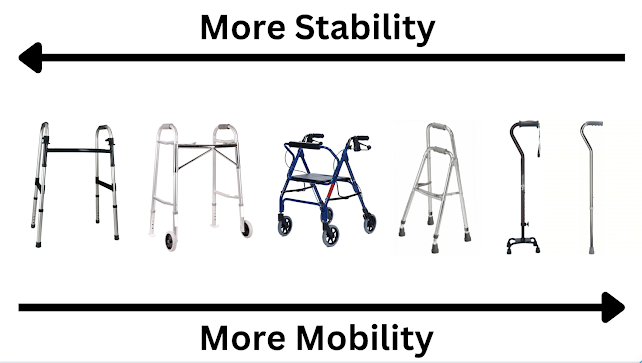Choosing the Right Mobility Aid: Canes vs Walkers
Let’s Start Here!
Mobility devices like canes and walkers play a crucial role in enhancing the independence and quality of life for many individuals. Whether you are exploring options for yourself or a loved one, it's essential to understand the different types of canes and walkers available and how to determine if they are appropriate for your specific needs. In this blog, we will delve into the world of mobility aids, explaining the various types of canes and walkers and offering guidance on selecting the most suitable one.
It is also recommended to check out www.PTRecommends.com for clinically recommended devices.
Understanding the Basics
Before we dive into the specific types of canes and walkers, it's important to grasp the fundamental concepts associated with these mobility aids.
The above chart showcases the basic fundamentals of why someone might need a cane vs a walker. Walkers provide more stability, whereas canes offer more mobility. Think about it like this: most walkers have four points of contact with the ground, which provides more stability. If someone requires increased assistance from their device due to lack of balance or not being allowed to put any weight through their foot, a walker could be the correct device. On the other hand, someone who only needs a little stability to make them feel safe may benefit from a cane.
1. Canes:
- Canes are simple, single-pointed or multi-pointed devices used for stability and balance support.
- They come in various materials, including wood, metal, and carbon fiber.
- Canes are typically ideal for individuals with mild balance issues, weakness, or minor mobility challenges.
- They can be used in either hand, providing support for walking or standing.
2. Walkers:
- Walkers are more comprehensive mobility aids, designed to offer greater stability and support.
- They often have four legs or wheels and may include additional features like brakes and seats.
- Walkers are suitable for those with more significant mobility limitations, such as those with limited strength, joint issues, or post-surgery recovery.
Types of Canes
1. Standard Canes:
- These are the most common canes, featuring a single-pointed base and a straight or slightly curved handle.
- Standard canes are versatile and can be used by many individuals with minor balance or stability concerns.
2. Offset Canes:
- Offset canes have a handle that is bent or offset from the shaft.
- This design offers better weight distribution and balance for users, making them a good choice for those with mild to moderate mobility challenges.
3. Quad Canes:
- Quad canes have a four-pointed base for added stability.
- They are ideal for individuals with significant balance issues or weakness and provide excellent support on various terrains.
Types of Walkers
1. Standard Walkers:
- Standard walkers have a simple, non-wheeled design with four rubber-tipped legs.
- They are suitable for individuals who require strong support and stability during walking.
2. Rolling (Wheeled) Walkers:
- These walkers are equipped with wheels on the front legs, making them easier to maneuver.
- Wheeled walkers are ideal for those who need mobility assistance but can still bear some weight on their legs.
3. Rollators:
- Rollators are four-wheeled walkers with handbrakes and a seat.
- They are perfect for individuals with limited strength and endurance and provide a convenient way to rest when needed.
Selecting the right mobility aid involves a few crucial considerations:
1. Consultation with a Healthcare Professional:
- Before making a decision, it's advisable to consult a healthcare professional, such as a physical therapist or physician, who can assess your needs and recommend the most appropriate device.
2. Personal Mobility and Strength:
- Evaluate your current mobility and strength. Determine if you need occasional support or continuous assistance, as this will help you choose between a cane or walker.
3. Lifestyle and Terrain:
- Consider your daily activities and the terrain you encounter. A cane may suffice for indoor use, but if you need to navigate uneven outdoor surfaces, a walker might be a better choice.
4. Budget and Personal Preference:
- Factor in your budget and personal preferences, such as the cane or walker's style and material.
Let’s Wrap This Up!
Choosing the right mobility aid can greatly improve your or your loved one's quality of life. By understanding the various types of canes and walkers and considering your unique needs, you can make an informed decision. Remember, consulting with a healthcare professional is always a wise step to ensure the appropriate choice for your mobility and safety. The right mobility aid can open up a world of possibilities, providing support and independence.










